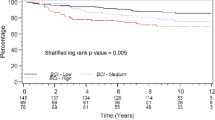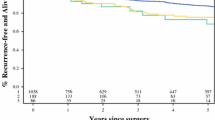Abstract
Global gene expression profiles, consisting mainly of genes associated with proliferation, have been shown to subdivide histological grade 2 breast cancers into groups with different prognosis. We raised the question whether this subdivision could be done using a single proliferation marker, cyclin A. Furthermore, we combined cyclin A (CA), histological grade (G), and estrogen receptor—ER (E) into a new variable, CAGE. Our aim was to investigate not only the prognostic importance of cyclin A alone but also the value of the combination variable CAGE. In 219 premenopausal node-negative patients, cyclin A was assessed using immunohistochemistry on tissue microarrays. High cyclin A was defined as above the seventh decile of positive cells. Only 13% of the patients received adjuvant systemic therapy. Cox proportional hazards regression was used to model the impact of the factors on distant disease-free survival (DDFS). Cyclin A divided histological grade 2 tumors into two groups with significantly different DDFS (hazard ratio [HR]: 15, P < 0.001). When stratifying for ER status, cyclin A was a prognostic factor only in the ER positive subgroup. We found that CAGE was an independent prognostic factor for DDFS in multivariate analysis (HR: 4.1, P = 0.002), together with HER2. CAGE and HER2 identified 53% as low-risk patients with a 5-year DDFS of 95%. A new prognostic variable was created by combining cyclin A, histological grade, and ER (CAGE). CAGE together with HER2 identified a large low-risk group for whom adjuvant chemotherapy will have limited efficacy and may be avoided.



Similar content being viewed by others
References
Bukholm IR, Bukholm G, Nesland JM (2001) Over-expression of cyclin A is highly associated with early relapse and reduced survival in patients with primary breast carcinomas. Int J Cancer 93(2):283–287. doi:10.1002/ijc.1311
Kuhling H, Alm P, Olsson H, Ferno M, Baldetorp B, Parwaresch R, Rudolph P (2003) Expression of cyclins e, a, and b, and prognosis in lymph node-negative breast cancer. J Pathol 199(4):424–431. doi:10.1002/path.1322
van Diest PJ, van der Wall E, Baak JP (2004) Prognostic value of proliferation in invasive breast cancer: a review. J Clin Pathol 57(7):675–681. doi:10.1136/jcp.2003.010777 57/7/675 [pii]
Baldini E, Camerini A, Sgambato A, Prochilo T, Capodanno A, Pasqualetti F, Orlandini C, Resta L, Bevilacqua G, Collecchi P (2006) Cyclin a and e2f1 overexpression correlate with reduced disease-free survival in node-negative breast cancer patients. Anticancer Res 26(6B):4415–4421
de Azambuja E, Cardoso F, de Castro G Jr, Colozza M, Mano MS, Durbecq V, Sotiriou C, Larsimont D, Piccart-Gebhart MJ, Paesmans M (2007) Ki-67 as prognostic marker in early breast cancer: a meta-analysis of published studies involving 12, 155 patients. Br J Cancer 96(10):1504–1513. doi:6603756[pii] 10.1038/sj.bjc.6603756
Stuart-Harris R, Caldas C, Pinder SE, Pharoah P (2008) Proliferation markers and survival in early breast cancer: a systematic review and meta-analysis of 85 studies in 32, 825 patients. Breast 17(4):323–334. doi:S0960-9776(08)00059-3[pii] 10.1016/j.breast.2008.02.002
Baak JP, Gudlaugsson E, Skaland I, Guo LH, Klos J, Lende TH, Soiland H, Janssen EA, Zur Hausen A (2009) Proliferation is the strongest prognosticator in node-negative breast cancer: Significance, error sources, alternatives and comparison with molecular prognostic markers. Breast Cancer Res Treat 115(2):241–254. doi:10.1007/s10549-008-0126-y
Goldhirsch A, Ingle JN, Gelber RD, Coates AS, Thurlimann B, Senn HJ (2009) Thresholds for therapies: highlights of the St Gallen international expert consensus on the primary therapy of early breast cancer 2009. Ann Oncol 20(8):1319–1329. doi:mdp322[pii] 10.1093/annonc/mdp322
Michalides R, van Tinteren H, Balkenende A, Vermorken JB, Benraadt J, Huldij J, van Diest P (2002) Cyclin a is a prognostic indicator in early stage breast cancer with and without tamoxifen treatment. Br J Cancer 86(3):402–408. doi:10.1038/sj.bjc.6600072
Poikonen P, Sjostrom J, Amini RM, Villman K, Ahlgren J, Blomqvist C (2005) Cyclin a as a marker for prognosis and chemotherapy response in advanced breast cancer. Br J Cancer 93(5):515–519. doi:6602735[pii] 10.1038/sj.bjc.6602735
Ahlin C, Zhou W, Holmqvist M, Holmberg L, Nilsson C, Jirstrom K, Blomqvist C, Amini RM, Fjallskog ML (2009) Cyclin a is a proliferative marker with good prognostic value in node-negative breast cancer. Cancer Epidemiol Biomarkers Prev 18(9):2501–2506. doi:1055-9965.EPI-09-0169[pii] 10.1158/1055-9965.EPI-09-0169
Rudolph P, Kuhling H, Alm P, Ferno M, Baldetorp B, Olsson H, Parwaresch R (2003) Differential prognostic impact of the cyclins e and b in premenopausal and postmenopausal women with lymph node-negative breast cancer. Int J Cancer 105(5):674–680. doi:10.1002/ijc.11132
Konigsberg R, Rogelsperger O, Jager W, Thalhammer T, Klimpfinger M, De Santis M, Hudec M, Dittrich C (2008) Cell cycle dysregulation influences survival in high risk breast cancer patients. Cancer Invest 26(7):734–740. doi:795398532[pii] 10.1080/07357900801944864
Sotiriou C, Wirapati P, Loi S, Harris A, Fox S, Smeds J, Nordgren H, Farmer P, Praz V, Haibe-Kains B, Desmedt C, Larsimont D, Cardoso F, Peterse H, Nuyten D, Buyse M, Van de Vijver MJ, Bergh J, Piccart M, Delorenzi M (2006) Gene expression profiling in breast cancer: understanding the molecular basis of histologic grade to improve prognosis. J Natl Cancer Inst 98(4):262–272
Ivshina AV, George J, Senko O, Mow B, Putti TC, Smeds J, Lindahl T, Pawitan Y, Hall P, Nordgren H, Wong JE, Liu ET, Bergh J, Kuznetsov VA, Miller LD (2006) Genetic reclassification of histologic grade delineates new clinical subtypes of breast cancer. Cancer Res 66(21):10292–10301. doi:66/21/10292[pii] 10.1158/0008-5472.CAN-05-4414
Teschendorff AE, Miremadi A, Pinder SE, Ellis IO, Caldas C (2007) An immune response gene expression module identifies a good prognosis subtype in estrogen receptor negative breast cancer. Genome Biol 8(8):R157. doi:gb-2007-8-8-r157[pii] 10.1186/gb-2007-8-8-r157
Desmedt C, Haibe-Kains B, Wirapati P, Buyse M, Larsimont D, Bontempi G, Delorenzi M, Piccart M, Sotiriou C (2008) Biological processes associated with breast cancer clinical outcome depend on the molecular subtypes. Clin Cancer Res 14(16):5158–5165. doi:14/16/5158[pii] 10.1158/1078-0432.CCR-07-4756
Klintman M, Bendahl PO, Grabau D, Lovgren K, Malmstrom P, Ferno M (2010) The prognostic value of ki67 is dependent on estrogen receptor status and histological grade in premenopausal patients with node-negative breast cancer. Mod Pathol 23(2):251–259. doi:modpathol2009167[pii] 10.1038/modpathol.2009.167
Aleskandarany MA, Rakha EA, Macmillan RD, Powe DG, Ellis IO, Green AR (2010) Mib1/ki-67 labelling index can classify grade 2 breast cancer into two clinically distinct subgroups. Breast Cancer Res Treat. doi:10.1007/s10549-010-1028-3
Malmstrom P, Bendahl PO, Boiesen P, Brunner N, Idvall I, Ferno M (2001) S-phase fraction and urokinase plasminogen activator are better markers for distant recurrences than Nottingham prognostic index and histologic grade in a prospective study of premenopausal lymph node-negative breast cancer. J Clin Oncol 19(7):2010–2019
Elston CW, Ellis IO (1991) Pathological prognostic factors in breast cancer. I. The value of histological grade in breast cancer: experience from a large study with long-term follow-up. Histopathology 19(5):403–410
Ahlin C, Aaltonen K, Amini RM, Nevanlinna H, Fjallskog ML, Blomqvist C (2007) Ki67 and cyclin A as prognostic factors in early breast cancer. What are the optimal cut-off values? Histopathology 51(4):491–498. doi:HIS2798[pii] 10.1111/j.1365-2559.2007.02798.x
Jonsson G, Staaf J, Vallon-Christersson J, Ringner M, Holm K, Hegardt C, Gunnarsson H, Fagerholm R, Strand C, Agnarsson BA, Kilpivaara O, Luts L, Heikkila P, Aittomaki K, Blomqvist C, Loman N, Malmstrom P, Olsson H, Johannsson OT, Arason A, Nevanlinna H, Barkardottir RB, Borg A (2010) Genomic subtypes of breast cancer identified by array-comparative genomic hybridization display distinct molecular and clinical characteristics. Breast Cancer Res 12(3):R42. doi:bcr2596[pii] 10.1186/bcr2596
Schoenfeld DA (1983) Sample-size formula for the proportional-hazards regression model. Biometrics 39(2):499–503
Royston P, Sauerbrei W (2008) Multivariable model-building: a pragmatic approach to regression analysis based on fractional polynomials for continuous variables. John Wiley & Sons Ltd, Chichester
McShane LM, Altman DG, Sauerbrei W, Taube SE, Gion M, Clark GM (2006) Reporting recommendations for tumor marker prognostic studies (remark). Breast Cancer Res Treat 100(2):229–235. doi:10.1007/s10549-006-9242-8
Dowsett M, Goldhirsch A, Hayes DF, Senn HJ, Wood W, Viale G (2007) International web-based consultation on priorities for translational breast cancer research. Breast Cancer Res 9(6):R81. doi:bcr1798[pii] 10.1186/bcr1798
Eden P, Ritz C, Rose C, Ferno M, Peterson C (2004) “Good old” clinical markers have similar power in breast cancer prognosis as microarray gene expression profilers. Eur J Cancer 40(12):1837–1841. doi:10.1016/j.ejca.2004.02.025 S0959804904002138 [pii]
Cuzick J, Dowsett M, Wale C, Salter J, Quinn E, Zabaglo L, Howell A, Buzdar A, Forbes J (2009) Prognostic value of a combined ER, PgR, ki67, HER2 immunohistochemical (IHC4) score and comparison with the GHI recurrence score: results from transATAC. Cancer Res 69(Suppl 24):503S–503S
Meyer JS, Alvarez C, Milikowski C, Olson N, Russo I, Russo J, Glass A, Zehnbauer BA, Lister K, Parwaresch R (2005) Breast carcinoma malignancy grading by Bloom-Richardson system vs proliferation index: reproducibility of grade and advantages of proliferation index. Mod Pathol 18(8):1067–1078. doi:3800388[pii] 10.1038/modpathol.3800388 [doi]
Aaltonen K, Ahlin C, Amini RM, Salonen L, Fjallskog ML, Heikkila P, Nevanlinna H, Blomqvist C (2006) Reliability of cyclin a assessment on tissue microarrays in breast cancer compared to conventional histological slides. Br J Cancer 94(11):1697–1702. doi:6603147[pii] 10.1038/sj.bjc.6603147
Acknowledgments
We are indebted to participating departments of the South Sweden Breast Cancer Group for providing samples and clinical follow-up. We thank Dorthe Grabau for collection of paraffin blocks, Kristina Lövgren for technical skills in creating the TMA blocks, and Markus Ringnér and Göran Jönsson for fruitful discussions about genetic grade. The study was supported by funds from the Swedish Cancer Society, the Swedish Research Council, the Gunnar Nilsson Cancer Foundation, the Mrs. Berta Kamprad Foundation, the Anna and Edwin Bergers Foundation, Skåne County Council’s Research and Development Foundation, and Governmental Funding of Clinical Research within the National Health Service.
Conflict of interest
None declared.
Author information
Authors and Affiliations
Corresponding author
Rights and permissions
About this article
Cite this article
Strand, C., Ahlin, C., Bendahl, PO. et al. Combination of the proliferation marker cyclin A, histological grade, and estrogen receptor status in a new variable with high prognostic impact in breast cancer. Breast Cancer Res Treat 131, 33–40 (2012). https://doi.org/10.1007/s10549-011-1386-5
Received:
Accepted:
Published:
Issue Date:
DOI: https://doi.org/10.1007/s10549-011-1386-5




